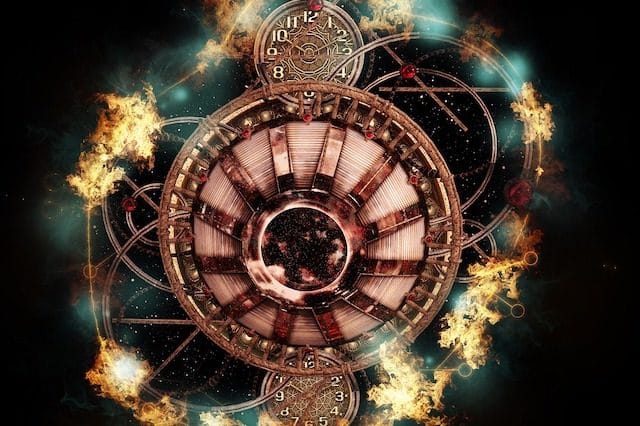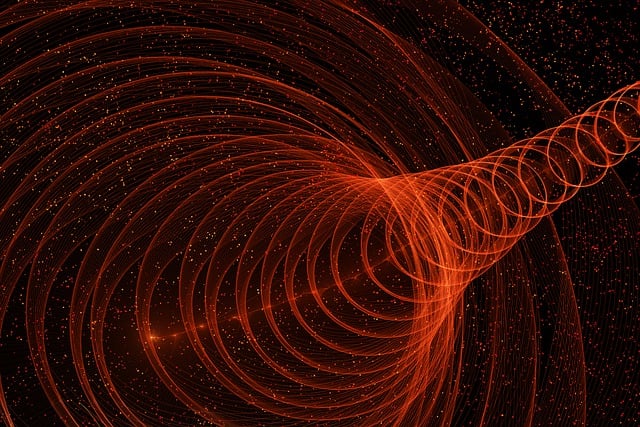One of science fiction’s favorite themes is time travel. HG Wells wrote The Time Machine back in 1895, but Gaspar wrote El Anacronópete in 1887, which also featured time travel. Charles Dickens hammered out A Christmas Carol in 1843, which also technically features a man traveling both to the past and future. Our fascination with the concept has endured ever since.
What makes time travel so appealing may be the fact that there are circumstances when science allows for the possibility of it happening, at least in theory. For instance, all of us are traveling into the future at this very moment. It happens nonstop at a speed of one second per second!
But that’s not what most of us mean when we say time travel, is it? We’re talking about going back and riding a dinosaur, or traveling way into the future and riding a robot dinosaur. So, is that possible? Let’s take a look!
Time Dilation and Clocks

Dr. Ana Alonso-Serrano has explained how space and time are not absolute values. Mathematically, which is to say on paper, you can account for literally curving space and time around so that you make it into a loop, which is what time travel is. But the problem is translating things from paper to reality. Physically speaking, we need to understand more before any of this could ever become real.
What we do understand, and can even demonstrate right now, is how time dilation works. The idea behind time dilation is that time actually passes differently for different observers, depending on several factors that affect it, including gravitational fields and relative motion. In very simple terms, as far as it can be most easily understood by us on the ground, speed and gravity affect time. All of this is part of the Theory of Relativity.
The relative part of relativity is where things come into play here. You’ve probably heard that if you’re on a rocket ship traveling near light speed, when 5 years pass for you, maybe 36 years will pass on Earth. That’s relativity in action. For you, it would never seem like you were somehow skipping ahead in time. You’re just traveling quickly. But relative to the people on Earth, you are traveling into the future.
A fun example of this, that we saw in the real world, was the comparison between identical twin brothers Scott and Mark Kelly. Scott spent one full year in orbit, traveling at 17,500 mph in much lower gravity than his brother experienced on Earth. When Scott returned from orbit, Mark was 5 milliseconds older than he had been compared to his brother, thanks to the effects of time dilation.
Experiments with atomic clocks in the 70s showed that those flown around the world on jets were off compared to those that stayed on the ground when they landed. The effect is the barest fractions of seconds and would never matter to a human during their lifespan, but it proves Einstein’s theory was true. More modern and even more precise clocks have confirmed this.
GPS satellites, because of their speed and altitude, have to have specially adjusted clocks. They gain around 38 microseconds every day and need to be reset continually, or they would never work properly on Earth. Each day, they would give coordinates that were off by 10 kilometers if they weren’t adjusted.
Time does travel differently based on relative conditions, and if we could achieve incredibly high speeds, the effect would be far more pronounced. You would, based on the observations of those you left behind, travel to the future. A hundred years could pass on Earth, but you might only age a few years, or even months, depending on the speeds achieved.
What’s Stopping Us From Traveling to the Future?

The big speed bump, quite literally, in achieving time travel-type speeds is mass. As you increase your speed, your mass increases, and that means you need more energy. This is why nothing can travel faster than light. You’d need infinite energy to move your mass at the speed of light, and that’s just not possible. Light, which has no mass, travels as fast as possible.
So let’s say you want to travel at a fraction of the speed of light. You still need a lot of energy. Doubling your speed requires quadrupling your kinetic energy. Tripling speed requires nine times the kinetic energy.
Mathematically, if you want to move a 50 kg weight at 1% the speed of light, you need 200 trillion joules of energy to do it, which is the average daily energy consumption of two million Americans. This is by no means impossible, but it’s not super practical or easy to do. Plus, the average space shuttle weighs 2 million kg, so you need to up the energy used accordingly.
Another thing to remember about this kind of time travel is that you’re going somewhere. If you just wanted to loop around space and come back to the Earth in the future, you could theoretically do that, but you could never go back. The future by traveling close to light speed is a one-way trip.
Speed and Time

Traveling close to the speed of light is one way, theoretically, to get to the future. But a lot of time travel is focused on going back to the past. Is that possible at all? One theory says that you could if you could go faster than the speed of light, which we just spent some time explaining is impossible. Still, this is in the realm of the theoretical, so let’s just play with it.
To an observer on Earth, if you were to leave in a vessel traveling faster than light speed and then return, the people on Earth would see the vessel returning, they see it leaving in reverse, and they’d also see it park right where it took off from all at the same time. It only gets more complicated from there. But none of it really takes you to yesterday. It just ensures you’re always here and also in space, and also traveling in reverse.
Others, like Stephen Hawking, have argued that even if time travel into the past were possible, you could never travel to a time before you built the machine that let you travel back in time. It’s like saying you could never take the subway to any place that doesn’t have a subway stop.
Time Travel By Gravity

You may have heard that time slows down the closer you get to a black hole. Even if you were stuck on the Event Horizon of a black hole, time would stop completely. This has nothing to do with speed, but rather gravity. This is the other side of Einstein’s relativity coin. The more gravity, the slower the flow of time.
Time flows more slowly closer to the center of the Earth, and faster the further you get away from it. That’s partially why those atomic clock experiments work. It’s the Earth’s gravity affecting it. In theory, if we understood all the physics and had the technology to master it, we could use a black hole as a time machine. While minutes would pass in our time machine, years could potentially pass outside of the machine. You just have to make sure you don’t get pulled in, of course.
This effect is fictionalized in the movie Interstellar, where a planet exists near a black hole and time is drastically altered. In reality, this would probably never happen, but, again, theoretically, maybe.
Forward vs Back

So forward in time is possible in more than one way. But backwards? That’s a sticky wicket. The Laws of Thermodynamics don’t like reverse time travel because the universe can’t go back to the way it was. Things stay the same or they become more disordered over time; they don’t become more ordered, especially in the same way they used to be.
Traveling back in time presents a world of paradoxes that are hard to puzzle out. The Grandfather Paradox, for instance. If you went back in time and killed your own grandfather, thus preventing one of your parents from ever being born, and in turn preventing you from being born, how did you go back in time in the first place?
One attempt to explain this away is that you obviously didn’t kill your grandfather, and if anyone ever did, they never existed for the rest of us, and that’s why we don’t remember them to know that they did. So it’s not a paradox, it’s just that, if you did it, you’d never know you did because you never existed, and no one ever knew you did to say differently. How’s that for a brain buster?
Another theory, which researchers feel is mathematically sound, suggests that any paradox you create would inevitably resolve itself by necessity. Basically, time corrects itself no matter what.
In practical terms, traveling back in time through any traditional means is simply not possible, according to most scientists. But there are non-traditional means out there.
Special Cases for Traveling Back

Einstein again gives us the possibility of a shortcut to traveling back in time. Wormholes, passages that allow spacetime to curve back on itself and take you back to a place and time that has already happened, are a theoretical possibility. Extremely theoretical, in that no one has ever seen one before, and we have no evidence they exist, it’s just that science doesn’t preclude their existence.
Science fiction loves a wormhole because it makes travel through space and time convenient. And while an Einstein-Rosen Bridge sounds good on paper, we haven’t seen much evidence for one in real life yet. But space is vast, so you never know. More importantly, not everyone believes that, even if they did exist, they could be used to travel back in time.
If a wormhole could go to the past, how would that work? One theory suggests a tube in space-time that connects a black hole to a white hole. Mathematically, a white hole makes sense and is just what it sounds like, the opposite of a black hole. While nothing can escape a black hole, nothing can stay in a white hole. It shoots out energy the way a black hole sucks it in.
If a white hole connected to a black hole, the time dilation effect on one end could mean that, when you enter the hole, and when you leave the hole, are at vastly different times. So different, in fact, you could exit before you entered.
The big problem here is that, to cross through this wormhole, you need to get past the black hole event horizon, and that’s not technically possible.
Another potential path to the past is cosmic strings. A “one-dimensional topological defect” created at the beginning of time itself, these strings could create closed time-like curves which could, in theory, let us go back to the past.
A cosmic string theoretically formed when the universe was just being formed. As time and space and everything exploded out, there were little cracks or wrinkles, basically imperfections in the fabric of reality itself. Those are strings and, in theory, they can do a lot. If they date back to the beginning, and you could find one, you could ride that string back to any place in time.
Of course, if these strings exist, they would be volatile beyond words. Extremely dense and packing almost immeasurable energy, these things would be like lasers cutting through anything that got in the way, time travelers or planets included. You’d have to learn to navigate around one very carefully to travel in time.
If two strings crossed paths, a time machine could travel to the past along them.
As you have noticed, the word “theoretically” pops up a lot here. Things that work in equations don’t always work in reality, and we are far from having the ability to test any of this. It would take centuries to even find a black hole with our current technology, for instance. Then we still need to figure out how to navigate one.
Is time travel possible? Yes. We have even proven it with things traveling forward. But can we visit our ancestors, or the world of tomorrow, then be back in time for dinner? That’s looking like something that may never happen.